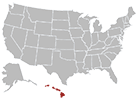
As a sterile processing technician, you’ll be responsible for managing medical tools, ensuring that they are properly working and clean.
This is a tremendous responsibility, as it helps ensure patient safety and prep equipment for medical professionals.
That said, training to become a sterile processing technician requires that you attend an accredited program.
If you’re in Hawaii, we’ll give you a breakdown of the best sterile processing technician schools.
Steps to Become a Sterile Processing Technician in Hawaii
If you’re interested in becoming a sterile processing technician in Hawaii, then there are a few paths you can take.
Mainly, you’ll want to attend an accredited sterile processing technician certificate program.
If not, then you can alternatively get on-the-job training or attend a related training program.
Below, we’ve outlined suggested steps to becoming a sterile processing technician.
Step 1: Meet Minimum Educational Requirements
The first step to becoming a sterile processing technician is to get a high school diploma or a GED.
This is a requirement that most sterile processing technician programs require.
In addition, a GED degree can be an acceptable form of schooling.
Step 2: Apply & Attend a Sterile Processing Technician Program
The next step will be to apply to an accredited sterile processing technician program.
Programs that are certified by the Certification Board for Sterile Processing and Distribution (CBSPD) and the International Association of Healthcare Central Service Material Management (IAHCSMM) are both acceptable.
Programs that aren’t accredited will not be acceptable as a form of training.
Step 3: Gain Additional Certifications
While not necessary, another step to further your advancement in a sterile processing technician career is to gain extra certifications.
The two certificates that can help the most are a Certified Registered Central Service Technician (CRCST) and a Certified Sterile Processing and Distribution Technician (CSPDT).
A CRCST and CSPDT is another certificate program that works with ensuring medical instruments and supplies are safe to use.
The job also requires that a CRCST and CSPDT sterilize equipment and prepare them for surgical use.
Essentially, these are the same role except the CRCST and CSPDT provide advanced education in sterile processing.
Step 4: Gain Experience
If you’re not finding that your certification is enough, gaining some hands-on experience can help you land the job.
Many hospitals and medical facilities will transfer internships or volunteers into full-time sterile processing technicians.
You can choose to volunteer at your local clinics or apply for an internship.
Step 5: Network and Apply
Finding a sterile processing technician job can be as simple as networking or looking at your online job recruitment boards.
However, another good way to secure a job in Hawaii is by networking with healthcare professionals.
Hospitals, clinics, and other medical facilities are always looking for sterile processing technicians.
By networking, you may be able to find a job that may not be listed.
Licensing Requirements to Become
Unlike other states, Hawaii doesn’t have any licensing requirements to become a sterile processing technician.
However, it can be beneficial to attend a program to not only get proper training but also put your application ahead of others.
That said, if you plan to move up in the medical field, a sterile processing technician certificate can be a great place to start.
Sterile Processing Technician Programs in Hawaii
Since Hawaii doesn’t require applicants to have certificates before working as a sterile processing technician, there aren’t many certificate programs.
Those who struggle to find a program near them can either take an online course or apply to work as a Sterile Processing Trainee.
By doing so, students can bypass the certificate and get hands-on experience.

Hawaii Pacific Health
Hawaii Pacific Health offers a Surgical Instrument Processing Technician certificate.
While not named the same, the training covers similar aspects of a Sterile Processing Technician.
Students will learn to ensure medical requirements are readily sterilized and ready to use.
Program length is estimated at eight weeks and is both virtual and in-person.
The in-person section of the course is held at the Kapiolani Medical Center for Women & Children, Pali Momi Medical Center Straub Medical Center on Oahu, or Wilcox Medical Center on Kauai.
However, this program is only available on an on-demand basis.
The company only lists when the training is available.
So, potential students will need to contact Hawaii Pacific Health for future program dates.

Hawaii Community College
The Hawaii Community College offers an online program offered by Ed2Go.
Here, students can register year-round and prepare to be sterile processing technicians.
The course allows you to sit for the Certified Registered Central Service Technician certificate provided by the HSPA.
The program consists of 190 course hours and takes 12 months to complete.
Students can learn at their own rate, as the program is self-paced.
The program is designed to give complete knowledge of the sterile processor role and provide procedures, guidelines, and regulations.
Students can expect tuition to be$3,290 for the course but may find it listed on sale.
If students can’t pay the full tuition upfront, students can apply for Affirm.
Affirm can help students pay as little as $136 per month for the program.
2 Sterile Processing Technician Schools in Hawaii
| School Name | Address |
|---|---|
| Hawaii Pacific Health | 1100 Ward Ave #840, Honolulu, HI 96814, United States |
| Hawaii Community College | 1175 Manono St, Hilo, HI 96720, United States |
Salary
The average income for a sterile processing technician in Hawaii is $41,404.
On the high end, sterile processing techs can make up to $50,817.
On the low end, sterile processing techs can expect to make $32,351.
Technician compensation is highly dependent upon education, certifications, and experience.
In addition, location can be a big factor, as more remote locations will have lower pay.
Annual Salary Range:Average Salary of Sterile Processing Technicians in Hawaii
| City Name | Salary |
|---|---|
| Ewa Beach | $41,226 |
| Hilo | $40,949 |
| Kahului | $40,949 |
| Kailua | $41,226 |
| Ocean View | $40,949 |
| Pearl City | $41,226 |
| Waipahu | $41,186 |
| Makaweli | $40,949 |
| Kealia | $40,949 |
| Kapaa | $40,949 |
Regional Salary
| Region | Employed | Avg. Annual Salary | Avg. Hourly Pay | Top 10% Annual Salary | Bottom 10% Annual Salary |
|---|---|---|---|---|---|
| Urban Honolulu, HI | 260 | $51,230 | $24.63 | $59,360 | $41,600 |
* Employment conditions in your area may vary.
Frequently Asked Questions
How long does it take to become a sterile processing technician in Hawaii?
The length of time it takes to become a sterile processing technician in Hawaii depends on what qualifications you’re going for.
For example, someone attending a training program can learn in as little as ten weeks.
However, those who pursue certification may take one year or more.
What is the job outlook for sterile processing technicians in Hawaii?
The projected outlook for sterile processing technicians in Hawaii is estimated to grow by 7% over the next ten years.
These statistics are based on putting the sterile processing technicians under the category of Medical Equipment Preparers.
What are the typical work hours and shifts for sterile processing technicians in Hawaii?
The average sterile processing technician works a standard 40 hours a week.
Mainly, there are three different shifts, either the day, evening, or night.
There may also be rotating shifts or call-ins depending on staffing.
That said, most sterile processing technicians work the standard 40 hours.
What are the alternative programs for becoming a Sterile Processing Technician in Hawaii?
Becoming a Certified Registered Central Service Technician (CRCST) or a Certified Sterile Processing and Distribution Technician (CSPDT) can also be used to work as a sterile processing technician.
In addition, applicants may also attend a trainee position while working on the job.
That said, most sterile processing technicians end up in entry-level positions with on-the-job training in Hawaii.
Is a Sterile Processing Technician Certificate worth it in Hawaii?
While a Sterile Processing Technician Certificate is valuable, it’s not required in Hawaii.
If you don’t plan to continue your education in medical processing, then there isn’t much need to apply to a program unless you are looking for a competitive edge.
Students who do attend a certificate program will be highly considered for open positions.
This page is also available in Spanish.





